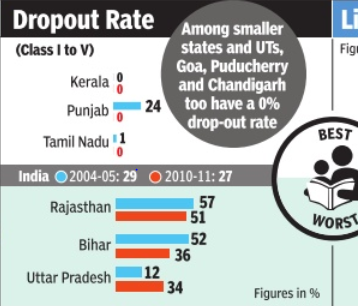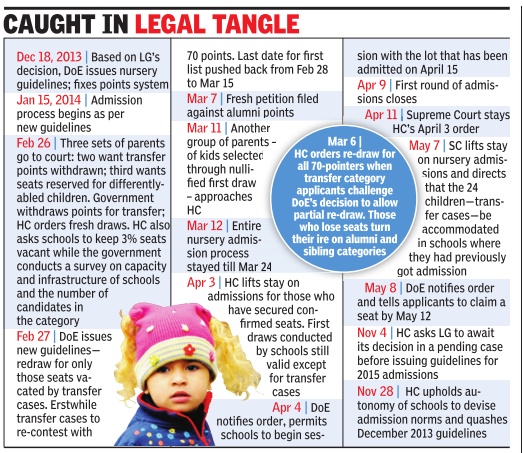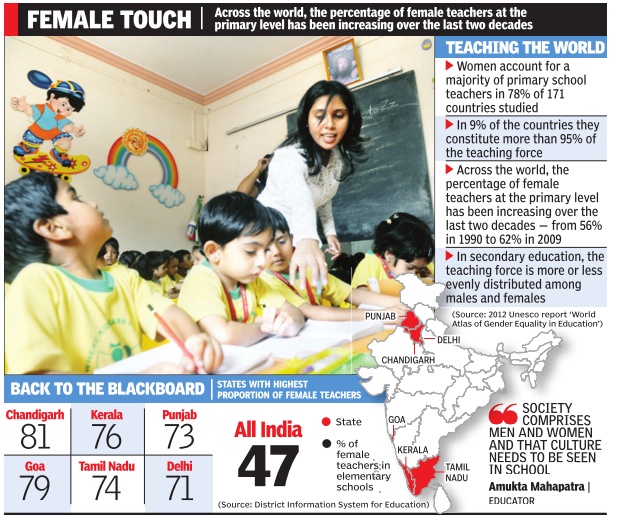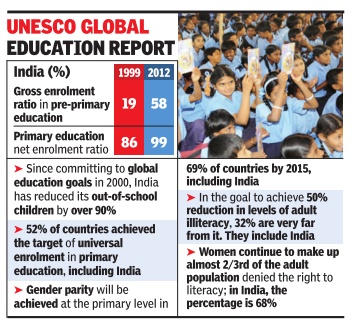Primary Education: India
This is a collection of articles archived for the excellence of their content.
|

Contents |
Private-unaided school's autonomy
Schools happy, talk about self-regulation
New Delhi TIMES NEWS NETWORK The Times of India Nov 29 2014
The nursery nightmare is far from over with more court battles looming ahead. Sources say the government is gearing up to appeal against Friday's high court order “as soon as possible“. Lawyer-activists Social Jurist, whose case had put the onus of framing guidelines at the LG's door, will also file a plea. And finally , there's a case in Supreme Court on the applicability of Right to Education Act on nursery admissions, Khagesh Jha, a lawyer, told TOI. “The decision on this case could be a gamechanger“. However, none of that is curbing the enthusiasm of school associations that see the HC order as vindication of the “right to autonomy“ of unaided institutions. The restoration of management quota has been particularly welcomed. “This is a victory of the private-unaided school's autonomy as the order clarifies that government has no role and can't interfere in admission in these schools. But now we have to ensure there is no violation. We'll have to think how we can restore people's faith in private schools, we have to be more responsible, more transparent,“ said S K Bhattacharya, president, Action Committee for Unaided Recognized Private Schools, a co-petitioner. He said a committee will be constituted to frame a `common policy'. “We will self-regulate.“ Friday's order permits private-unaided schools to choose their own parameters and assign points out of 100, as they had been doing from 2007 to 2012. There won't be common criteria or fixed points. Calling it a “landmark judgment,“ Ameeta Mulla Wattal, chairperson, National Progressive Schools Con ference, said the order “takes into cognizance that Delhi is not ready for that kind of guideline or even implementation of the neighbourhoodschool concept as there aren't enough schools“. “We have to ensure that autonomy isn't misused,“ said R C Jain, president, Delhi State Public Schools Management Association, “The restoration of management quota is only fair. There are requests from various quarters and we need to oblige those who helped us set up the schools, but if someone is using it TO MAKE MONEY and there's a complaint, let the department take action“. He said last year's nursery mess was over a few schools that are in areas developed by DDA. “One size doesn't fit all and this year schools can once again create guidelines that best suit them, the areas they are in and the children who attend them.“ The court order “giving a free hand to schools“ has deeply disappointed Social Jurist. “The choice of the parent has prevailed but not the right of the child,“ said Jha.
Female domination in teaching: Elementary schools
Gender disparity in class
The Times of India, Jan 08 2015, Ramya M
Teaching in schools in some states in India is a female-dominated field. Close to 81% of teachers in elementary schools in Chandigarh are female, while Tamil Nadu, Goa, Kerala, Punjab and Delhi have women as more than 70% of their teaching force.
This is much higher than the national average of 47.2%. The figures are based on a National University of Educational Planning and Administration document titled `Elementary Education in India: Trends', prepared based on statistics compiled by all the states and Union Territories for the District Information System for Education.
Across the world, too, the percentage of female teachers at the primary level has been increasing over the last two decades -from 56% in 1990 to 62% in 2009, according to a 2012 Unesco document titled `World Atlas of Gender Equality in Education'. The document adds that in 9% of 171 countries, for which data is available, women constitute more than 95% of the teaching force. The report added that teachers’ pay is a factor in the proportion of female teachers. “The proportion tends to be high in places where teacher salaries are low. By contrast, males tend to dominate the teaching force in countries where teachers are relatively well paid,” the report said.
Local teachers said one of the main reasons for the gender disparity in the vocation is the low salary offered by private schools. Many teachers find that they get little in return for the amount of work put in.
Though government schools pay good salaries, urban private schools offer low salaries. So, it’s usually women who take up teaching jobs in these schools.
Academics said in rural areas, however, the scene is different.
Male teachers, who usually wait for a government job, sign up for one in the employment exchange and, while waiting, start a farm project or become real estate agents to earn a living. Once they get the job in a government school, many take it up and continue to get additional income by pursuing their other venture on the side.
Private school managements and parents also seem to prefer women as teachers. “Schools and parents prefer female teachers. It’s become something of a habit,” said Amukta Mahapatra, director of Schoolscape, a centre for educators.
2006-14: unqualified teachers
Apr 05 2015
Subodh Varma
1 in 5 primary teachers not qualified
Elementary education suffers as just 30% of staff are qualified in some states
A fifth of all elementary school teachers in the country do not have the requisite qualifications to teach young children. If this doesn't shock you, take a look at what's going on at the state level. In a wide swathe starting from all eight states of the North-East (including Sikkim), through West Bengal, Bihar, Jharkhand, Chhattisgarh, Madhya Pradesh and up north in J&K, the share of qualified teachers is much lower, ranging between 29% in Arunachal Pradesh or 30% in Nagaland to 68% in MP and 70% in Jharkhand. It is through these untrained hands that the foundation of education is being laid in children.
What is even more worrying is that according to district information system for education (DISE) -it's a school education database managed by the National Uni versity for Educational Planning -this condition has persisted for past many years.
In larger states, 90% or more teachers are professionally qualified. In Odisha, the proportion is 79% while in Uttar Pradesh it is 78%. Karnataka (96%) and Punjab (88%) show decline in the proportion of qualified teachers. It's essential that teachers, especially of smaller children, be professionally trained, stresses Anita Rampal, professor at Delhi University's department of education. “Just knowing a subject or being a graduate is not sufficient qualification to become an elementary school teacher. You need to be trained in understanding the learning process of children, their diversity , and you need to develop necessary teaching skills under trained supervision,“ she said.
The situation in the eight North-Eastern states has been like this for many years.Elementary schools in Assam, the biggest state of the region, are running on just 39% trained teachers, virtually the same share as in 2006-07.Arunachal Pradesh has slid from having 35% trained teachers in 2006-07 to 29% now, while Mizoram is facing a calamity -its share of trained teachers has plummeted from 61% in 2006 to 40%. Tripura and Sikkim have seen improvements, but at a worryingly slow pace.
Bihar has one of the lowest shares of trained teachers, because teachers training colleges remained closed for about a decade, says Rampal, who explains the condition in North-East as arising from lack of teachers train ing colleges. In 2006-07, the share of qualified teachers in Bihar was 62%, which has now reduced to 43%. In West Bengal, too, the situation is fast sliding as the share of qualified teachers went down from 75% in 2006-07 to 49% in 2013-14.
In Chhattisgarh, with 59% share of qualified teachers, and in Jharkhand with 70%, there has been only a marginal improvement in the past seven years. A similar situation exists in J&K where only 51% teachers were qualified in 2006-07 and now this share is 52%.
School education is in the concurrent list of the Constitution with both, the states and Centre having power to deal with it. The regulation of teachers' qualification is done by a Central statutory body , the National Council for Teachers' Education. While it is mandatory for states to appoint qualified teachers to schools, clearly , the law is being brazenly flouted.
1999-2012: pre-primary education
Apr 09 2015
Manash Gohain
India made big gains in child edu: UN
Enrolment in pre-primary 58% in 2012
India has made significant strides in the past 15 years, but remains far from reducing adult illiteracy.
A UNESCO global education report that human resource development minister Smrit Irani would release has revealed this.
The report said gross en rolment ratio in pre-primary education touched 58% in 2012, compared to 19% in 1999. Primary education ne enrolment ratio reached 99% in 2012. India has reduced its out-of-school children by over 90%. Globally 52% of countries including India achieved universal enrol ment in primary education.
India is predicted to be the only country in South and West Asia to have an equal ratio of girls to boys in both primary and secondary education this year. Unesco's Global Monitoring Report (GMR) director Aaron Benavot praised India for making exemplary progress in helping children gain access to pre-primary and primary education since the global education goals were set in 2000.
“India's example clearly shows that with sufficient political will and resources the world can step up to meet the new education targets by 2030,“ said Benavot.



